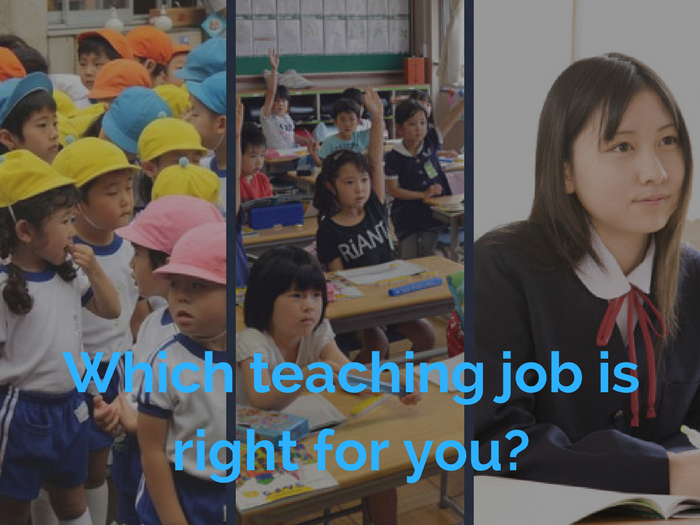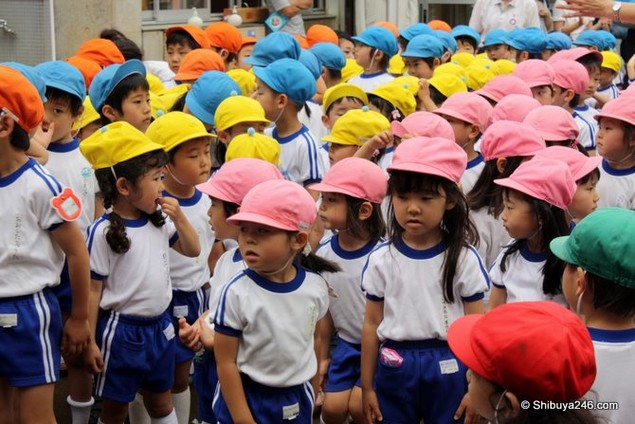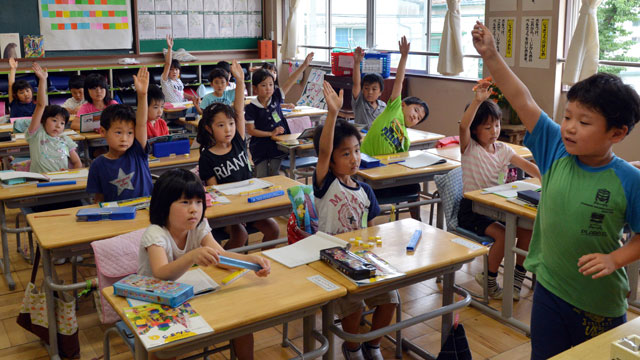
Getting a teaching job in Japan isn’t just about picking the first place that pays a decent salary. If you follow that logic, you’ll probably end up in a job that makes you miserable, even if it does pay you pretty well. Is it worth a year or more of your life in a miserable job to just go by salary alone? I didn’t think so.
Here are some of the salient facts about each kind of teaching job in Japan so you can decide which one is right for you. I wish I could tell you but this is one you’ll have to figure out for yourself, but I did manage to find out pretty fast which age group I liked teaching by working for an eikaiwa. I taught kids as young as three and as old as seventeen so I had an opportunity to see which age group I felt most comfortable with. If you can, getting your first job or second job in Japan in an eikaiwa will give you a headstart on where you need to go.
Kindergarten:
Kindergarten is, as Robert Fulgham said, where kids learn everything they really need to know. If you’re thinking of being a kindergarten teacher, you won’t find any other job in the world with more hugs, dancing, singing or running than this one. It can be one of the most rewarding jobs you’ll ever have, which is why I personally was teaching kindergarten for a high proportion of my teaching career.

You will need to put up with a lot though, and you’ll feel like you need to bring twice as much energy to this job as any other you have had in your life. Kids can be tough work no matter where you go, and not even being able to communicate with them in a language they understand just adds to the difficulty here. Having said that, watching students learn how to communicate and especially working with some who just ‘get’ language is an absolute joy.
Elementary:
In Japan while they have grades one through six, you’ll most likely be teaching grade five or six as this is the age where compulsory English education starts. Children this age are still excitable and can be really funny, and I really enjoy teaching this age group as they have a lot of character and just want to have fun. If you can adapt your teaching style to make them happy, you’ll be set.
Mostly their level will be very low though, and you might be surprised that they don’t learn English nearly as quickly as kindergarteners. The main goal of these classes as far as the school is concerned is to give them some exposure to English before they start getting tested on it in junior high, so they tend to want you to give the kids basic vocab words and a few short A/B answer templates like “How are you?” which leads to the typical “I’m fine thank you.” Games work well for kids this level, so you’ll want to have lots of them up your sleeves for any downtime.

Often you won’t need to spend too much time planning these classes, as requirements are very basic. You’ll often teach at multiple schools as there isn’t a regular requirement of English at this age (though this is changing soon), so once per week or even once per month at any given school is pretty standard. You might get bored teaching the same class over and over to kids, but that just gives you a chance to make the class better and better each time you do it and get your lesson planning down to a fine art.
Junior High School:
Junior high is for children aged 12-15, and it can be any mixture of great and horrifying. This is the time when the Japanese education system gets serious about English, and also happens to be when teenagers become… well… teenagers. You’ll find that your experience teaching in junior high varies from class to class, with some classes being amazing and full of bright and engaged students, and others being asleep before, during and after you come in to do your lesson. Empathy and calm are critical to your survival as a teacher in this environment. All of these students have their own stories and no rules can help you to deal with this more than empathy. They are often struggling to go through sixty hour weeks of study and academic rigour, and when you come in talking at them in a foreign language they may just shut down, as there are no real consequences for them to do so. You can try to punish them, but that will make your classes a struggle all year round and I highly advise that you apply the ‘carrot’ over the ‘stick’ method.
An example from my experience: I once had a junior high second year student, let’s call him Hiro, who slept through every one of my classes. The Japanese teacher would just say “Leave him be, he never does anything.” I wondered why he was sleeping all day and felt a little bit annoyed that he was sleeping in my class. It was only halfway through the year that I learned that his parents owned a ramen shop and had him working in there serving salarymen after-work noodles until 2am every single night. He was exhausted, and school wasn’t helping his family make rent for their house right now, so he slept through it. After I found this out I made a lot more effort to understand my students lives in order to reach them, and recognise that my English class might not be their top priority.
You might also get a chance to join after-school clubs here, and really this was the best way I reached my students when I taught junior high. Using English to help teach basketball, joining the big band group if you have an interest in music, or even just going to the gardening club and making the students feel good about what they are passionate about is a great way to connect with them and help your English classes be filled with students who know you care about them. Don’t be afraid to go to their games on a Saturday or after school. It’s actually really fun and the students appreciate it more than anything.
Senior High School:
By this stage if your students have decided that they aren’t interested in English, you’ll have little opportunity to change their minds. Some will already be able to speak a bit and might be considering majoring in English at university, but these will likely be a minority in your classrooms in a standard public senior high. In some schools you’ll find that many of the students just want to pass the English tests to get to university and then never study again.
There are also private high schools and university connected high schools that will likely have higher level students, and these can be really great places to stretch your wings as a teacher. Planning lessons with capable students who can basically communicate in English is a challenge and takes a bit more time, but it is totally worth it to be a part of some of the best English education these students receive. Remember, up to this point most senior high students have only been through the standard junior high English courses, which can often be dry, hard work and totally focused on grammar and vocabulary. Once they have a base, you can start helping them develop fluency at this level.
Just like junior high, there are speech and debate competitions that you may be asked (or want to) prepare students for, as well as students applying to study abroad which will give you opportunities to help them get ready for what will be a big shift from what has been expected of them up to this point. I’ve learned a lot teaching at senior high and it is one of those areas where you can see the biggest improvements in your students in a short time.
University

This is a tough one to get into, and you generally need a masters degree, but nothing really compares to university work if you want a long-term career in Japan.
- Full-time eikaiwa teachers hustle to try and break ¥3 million per year. Full-time university positions pay at least double that.
- Full-time eikaiwa teachers may have up to 40 teaching hours per week. Full-time university positions range from 10-20 teaching hours per week.
- Eikaiwa teachers get extremely limited time off, often not being able to take vacations until at least six months after joining, sometimes only in their second year, and even then only 10 days per year are paid. University teachers get between 1-3 months off per year, fully paid.
- Eikaiwa teachers are commodities, replaceable, typically powerless, and are forced to teach whatever material their company gives them. University teachers are much more difficult to replace, they often have influence within their department, and autonomy to create the kind of lessons they want.
The list could go on and on.
If you are planning to be in Japan for a while, getting qualified (Master’s degree minimum) for university teaching jobs in a great way to set yourself up for a highly paid and respected career.













